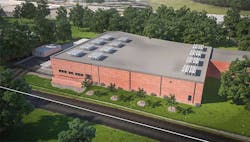The Edge Is Where the Customer Needs It to Be
Phillip Marangella, Chief Marketing Officer at EdgeConneX, explores the factors that are driving the data industry to the edge.
Phillip Marangella, Chief Marketing Officer, EdgeConneX
Edge computing, according to conventional wisdom, localizes data acquisition and control functions, as well as the storage of high bandwidth content and applications in close proximity to the end user. Edge solutions are inserted into the logical end point of a network, whether the public internet or a private network, creating a more distributed computing cloud architecture. Edge deployments circumvent the distance, capacity constraints, multiple network hops, and centralized processing loads that exist in traditional internet architecture.
The continuous demand for speed and bandwidth, combined with the need to lower latency, is driving the move to the edge. However, while the above definition provides a perfectly serviceable framework to jumpstart discussion, I would advocate a more focused definition that is at once far broader and meaningful. The edge is really where the customer needs it to be.
What’s consistent among all of these buyers and sellers of IT solutions in a data center is location, location, location.
The Edge That Empowers the Customer
Whether a micro site is at a cell tower or a hyperscale data center, from the customer’s perspective, the edge is a means to deliver successful business outcomes. Regardless of the specific scale, workload or location, empowering customers whereby their services perform better at lower costs due to ideal proximity is the raison d’être of edge infrastructure.
My colleagues and I have a deep history of providing these solutions for customers and can readily attest that content providers want their media to be proximate to consumer eyeballs in order to deliver a superior viewing experience. Cloud service providers seek access and/or their availability zones to be proximate, scalable and economical when expanding existing or penetrating new markets. Autonomous vehicle providers need their sensor data to be highly proximate to support ultra-low latency requirements in order to ensure safe driving and avert potentially dangerous collisions. And lastly, enterprises require a combination of different service providers available more locally so they can have access to integrated solutions for hybrid, multi-cloud solutions in their own neighborhood.
What’s consistent among all of these buyers and sellers of IT solutions in a data center is location, location, location. However, the solution is not solely data center location in and of itself. Truly empowering edge solutions delivers lower latency, optimal performance, reduced costs and positive ROI — imperatives that other providers in this space have neglected at their own peril — as well as adhere to stringent security and compliance requirements.
Achieving Visibility at the Edge
Ideally, customers deploying edge solutions also benefit from an intelligent automation and data center management platform that provides visibility into all of their capacity on a single pane of glass. For example, EdgeOS, an innovative data center information manager (DCIM) solution developed by EdgeConneX, allows customers to manage their services, assets, and support across all our data centers from a single web portal.
With the mainstreaming of IoT, and as digitally connected devices increasingly influence every aspect of our lives, including our public infrastructure, streets, homes, offices, and even our bodies, security concerns cannot be overemphasized. Gartner predicts that 20.4 billion connected things will be in use worldwide by next year. Meanwhile, a recent study by Trustwave, which assessed the current use of IoT technologies among organizations in a wide-range of industries, found that 61 percent of those surveyed have already experienced an IoT-related security incident.
But whether accommodating the IoT, cloud, video, multiplayer gaming, artificial intelligence, or other bandwidth-intensive, latency-sensitive applications, edge solutions must answer the call and empower customers in any global market and in support of any deployment, while also solving for scalable power and connectivity requirements. This means enabling their services by identifying where their edge needs to be deployed or built, selecting optimal locations, designing premium and purpose-built facilities, and then rapidly deploying infrastructure — wherever it needs to be.
The Next Edge
EdgeConneX built a global footprint of local data centers to support all type of Edge requirements for customers. We work with our customers to define, build, and deliver data center capacity that brings the Edge to our customers and our customers to the Edge — where they need it, when they need it, in the configurations they demand, to optimize the global delivery and access to content, cloud, networks, and applications. As the pioneer in defining and building the Edge, EdgeConneX has built and delivered a full spectrum of data center solutions, from Hyperscale facilities to Edge Data Centers®, Edge Small Cells and Edge PoPs® at the most critical locations—as close as possible to the end user’s point of access, from local metro services to global Cloud, Content, and Network providers.
Phillip Marangella is Chief Marketing Officer at EdgeConneX.


